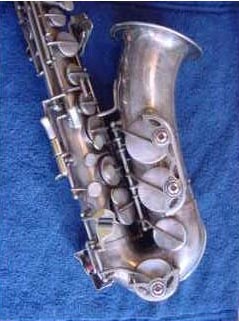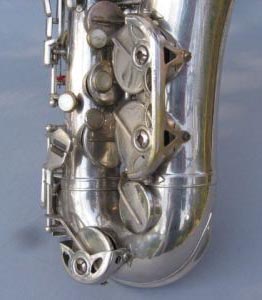The Keilwerth New King & Tone King
- There are alleged differences between these models:
- New King
- New King Special
- Toneking
- Toneking Special
- Toneking EX ("Exklusiv" or "Exclusive")
Early Tonekings have altissimo D# trill keys, the New Kings don't. The EX is supposed to have all the features of the Toneking and may have additional engraving and additional pearl inlay. The Special model of whichever version is supposed to be almost identical to the Toneking EX model, but without the pearl inlay and seem to feature altissimo F# keys.
Unfortunately, these rules are hardly rock solid: there are Special models without rolled tone holes and some Tonekings with straight tone holes. In other words, probably it's just a marketing thing and the only constant and fundamental difference between the New King and Toneking (excepting Special models) is that the Toneking has an altissimo D# trill key -- up to a certain serial number range (when the H-Couf was introduced). So, if you see a New King model with rolled tone holes, it's as good as the Toneking EX, it just doesn't look as fancy and doesn't have an altissimo D# trill. There is no data to back up an assertion like, "The New King uses older tooling than the Toneking" (for instance, as is the difference between the SML and SML Standard models).
However, if you can read German, go ahead and take a look at this article.
There is a possibility -- even probability -- that the Toneking neck, bell and/or bow were "tweaked" over New King models. I can easily accept this. Unfortunately, I don't know anyone that's taken a caliper and measured -- and, even if he did, Keilwerth is known to have tinkered with each of these components during the horn's existence.
Anyhow, the New King design was Keilwerth's most often stencilled horn -- sometimes unengraved, sometimes custom engraved -- but you can always tell it's a New King by the distinctive lucite keyguard on the Series III of these horns. And all Keilwerth stencils do have the "JK Best in the World" trademark.
But what of the King model (Modell 3)? I don't know. There are only a few of these out there and in two different "series": a very early split-bell-key horn and a single-side-bell-key horn with wire keyguards, very much like the Champion model. (Hey, there isn't a page for those! Glad you noticed.)
Rough Breakdown
- There are several different incarnations of the New King/Toneking design:
- Series 0: Wire-keyguard design. Unknown serial number range, but fairly early.
- Series I: from about 10xxx to 20xxx: In my opinion, the nicest model. An elaborately engraved horn with funky offset side chromatic Bb/C and altissimo E vent keys, a microtuner neck and rolled tone holes. Oddly, the Toneking model lacks the offset side keys and additional pearl keytouches of the New King model. I don't have enough data to determine if the bore is any different. Maybe, but, considering that these horns were made in such low quantities, it's more probable that it's not.
- Series II: beveled tone holes and left-hand bell keys were used on about 500 to 1000 horns after Keilwerth moved from Czechoslovakia to Germany. These horns are such a radical departure from the Series I, they could be considered a completely different model. I believe this is intentional, as Amati co-opted the Toneking name and design (see below). There may also not have been any Tonekings of this series.
This model may have been developed in conjunction with Kohlert, as some rumors suggest.
The other interesting thing about these horns is that they're one of the four I'm aware of that had beveled tone holes. The others are early Couesnons, Martin and some early Bueschers.
There are also at least two generations of these horns: bell keys on the left or bell keys on the right. They otherwise look identical.
- Series III: from about 21xxx to 45xxx: The introduction of the horns with the stunning lucite keyguard -- but the elimination of the microtuner neck. Rolled tone holes seem to be added randomly to these models.
I've been asked about the horns that have METAL keyguards in the same shape as the lucite ones: are they original? My answer: possibly.
I can imagine, because the lucite keyguards are so brittle, that after a year or two, Keilwerth offered the metal guard as an option -- or they used them as warranty replacements. However, I've been unable to find a serial number range for "just metal" or "just lucite", so the idea that the metal keyguards are replacements, either from the factory or other 3rd party company, is probably the most accurate.
- Series IIIa: In 1956, an interesting horn shows up: the V. Kohlert & Sons model with a label on the back, that reads, "JGK: The Best in the World" and "Made in Czechoslovakia". It's an odd horn because it doesn't look like any other New King model. The reason for this is because I don't really believe it's a Keilwerth, but an Amati horn. Take a look at the below article regarding the Amati Toneking and my notes on the Kohlert page.
- Series IV: from about 45xxx to 905xx. These are a somewhat cheaper looking horn, with sheet-metal keyguards. This is the series that the extremely famous H-Couf, Conn DJH Modified, King Tempo, Armstrong Heritage, Bundy/Bundy Special (and a few others) are stenciled from.
I can confirm that the Keilwerth-made Bundys are great horns, but remember that they were marketed as student horns and may be made from lower quality materials and may lack in some features (see, for instance, this link, which compares a Series I to an Esquire model tenor).
There are very few New King baritones -- of any series. Keilwerth definitely did make baritones for Selmer (in the form of the Bundy -- there were no Bundy Special baritones). According to the defunct Keilwerth Forum, the baritone was custom-made model up until the H-Couf product line. The bass was probably not even introduced until the H-Couf model line and, according to advertisements from that time, if you wanted an H-Couf bass, you needed to submit a deposit and wait six months.
Speaking of basses, there were a limited quantity of low A basses produced late in the Series IV-range. Let me quote from the original eBay ad:
This instrument is one of only two made and is in excellent original condition. Here's the story!! This sax came out of the Keilworth [sic] factory a few years ago. The factory had two graduating apprentices, and for their final project were given the task of making a Low A bass each. The sax has no markings at all and no sn# as it is a handmade prototype, (You can tell its handmade as can see where they have moved a few posts etc (trial/error) for the keywork.) A major dealer in Europe bought them both from the factory, sold one to Switzerland and here's the other!!!!
The Amati Toneking
The Toneking model name was co-opted by Amati when they nationalized the Keilwerth plant in Graslitz, Czechoslovakia (1946). These horns are shockingly similar to Keilwerth-made Tonekings of a couple years earlier. Here's some parallels and contrasts:
|
||||||||||||||||
I think that you can forward the argument -- especially because of the late serial numbers on some Amati horns (which go into the Series III serials) -- that the Amati Toneking was made with Keilwerth equipment for the most part, with some minor tooling changes for the neck.

